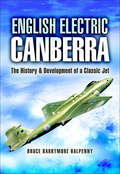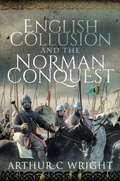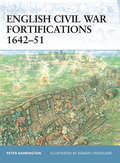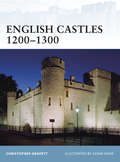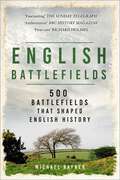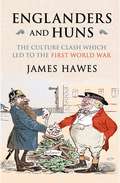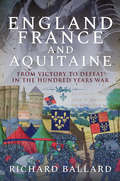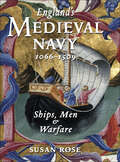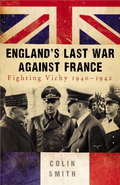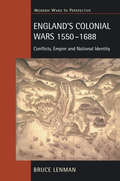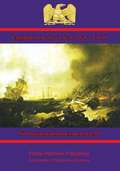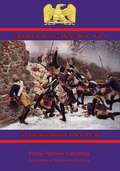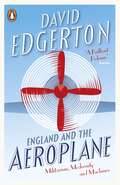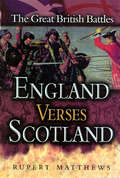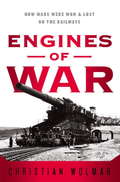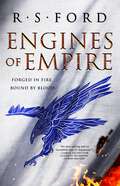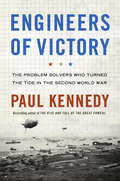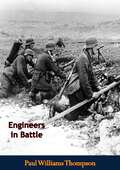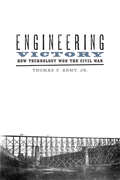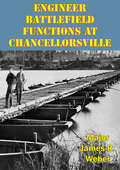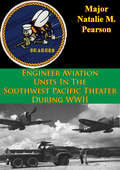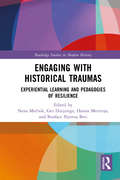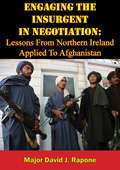- Table View
- List View
English Electric Canberra: The History & Development of a Classic Jet (Pen And Sword Large Format Aviation Bks)
by Bruce Barrymore Halpenny&“A useful review of the development of a classic jet bomber that saw widespread service in the Royal Air Force and was exported to many overseas air forces.&” —Aeromilitaria This amazing airplane first flew in 1949 and is still in front-line service with the RAF. It has served in a variety of roles including those of tactical bomber, photo-reconnaissance, navigational trainer, maritime strike, electronic countermeasures and target-towing. It was manufactured in the USA under license as the Martin B-57 and has been exported to Argentina, Chile, India, Peru, South Africa and other Commonwealth countries. This book looks at the development of the aircraft during the early days of jet power and especially at its Rolls-Royce Avon powerplant. Each of the many marks and variants are described and illustrated by many remarkable and rare photographs. The type&’s record of service with RAF squadrons throughout its service life is given together with descriptions of the many experimental models that were used in the development of a variety of weapons and avionic systems. &“For an aircraft that has been the subject of countless books, the author still found a remarkable wealth of previously unpublished material on Canberra operations. A classic aircraft given the proper coverage it so richly deserves.&” —Airfix Model World &“A wonderfully researched tribute to this remarkable achievement, with a plethora of excellent photographs . . . Essential reading for any aviation enthusiast.&” —Pegasus Archive
English Collusion and the Norman Conquest
by Arthur Colin WrightA historical analysis of the warfare during the Norman Conquest of England, and a look at the truth behind the legendary victor, King William I.The reality of war, in any period, is its totality. Warfare affects everyone in a society. Here, for the first time, is a comprehensive analysis of eleventh century warfare as exposed in the record of the Norman Conquest of England. King William I experienced a lifetime of conflict on and off so many battlefields. In English Collusion and the Norman Conquest, Arthur Wright’s second book on the Norman Conquest, he argues that this monarch has received an undeserved reputation bestowed on him by clerics ignorant alike of warfare, politics, economics and of the secular world, men writing half a century after events reported to them by doubtful sources. How much of this popular legend was actually created by an avaricious Church?Was he just a lucky, brutal soldier, or was he instead a gifted English King who could meld cultures and talents? This is a tale of blood, deceit, ambition and power politics which pieces together the self-interested distortion of events, brutalizing conflict and superb strategic acumen by using and analyzing contemporary evidence the like of which is not to be found elsewhere in Europe.By 1072 King William should have been secure upon the English throne, so what went wrong? How did a Norman Duke and a few thousand mercenaries take and hold such a wealthy and populous Kingdom? Even in the “Harrowing of the North,” which probably saw the death of tens of thousands, who was really to blame and why did it happen?Praise for English Collusion and the Norman Conquest“Arthur C Wright’s fresh look at how things panned out before and after the invasion provides new and fresh evidence that should not be overlooked. Brilliant.” —Books Monthly (UK)
English Civil War Fortifications 1642-51
by Peter Harrington Donato SpedaliereThe techniques of European warfare were transformed during the 15th and 16th centuries by the use of gunpowder and by substantial progress in the effectiveness and destructive power of artillery. The series of conflicts in the 1640s, known collectively as the English Civil War, was the first in the British Isles that reflected this new reality. Sieges that aimed at isolating and reducing fortified places became the dominant instrument for prosecuting the war and protective fortifications were vital, for both the besieged as well as the besieger. This title describes how both the Parliamentarians and the Royalists made use of new fortification techniques throughout the course of this conflict.
English Castles 1200-1300
by Adam Hook Christopher GravettThe simple castles raised after the Norman conquest had been developed throughout 11th and 12th centuries, whilst the introduction of Islamic and Byzantine fortification techniques from the late 12th century led to further developments in castle architecture. These fortifications were to be well tested throughout the course of the 13th century as England was riven by the conflict, characterized by prolonged sieges, between the monarchy and powerful magnates. As well as providing the focus for warfare, castles increasingly became the centres of their communities, providing a more permanent base for the lord, his family and retainers, as well as acting as centres for justice and administration.
English Battlefields: 500 Battlefields That Shaped English History
by Michael Rayner'Fascinating' - The Sunday TelegraphEngland has been fought over for centuries, by invaders and in civil wars. The sites of these desperate struggles are as varied as the reasons they were fought over, be they fields, towns or fortresses, by land, sea or air. These haunted acres are places of commemoration, memory and, above all, history. These are the places where history was made, and as such they form a crucial part of the historic environment. By 'reading' them like any other form of historical evidence, much can be learned about the events which took place there. Through stripping away later features and land use with an eye for the ground, the battlefield historian can, with the use of contemporary accounts, archaeology and military history, reconstruct the events which have shaped the present. In this ground-breaking volume, covering over 500 battlefields, Michael Rayner unravels these various strands and weaves them back together to give clear, concise accounts of the battles which shaped England.
Englanders and Huns
by James HawesA completely fresh look at the enmity between Britain and Germany that all but destroyed Europe.Half a century before 1914, most Britons saw the Germans as poor and rather comical cousins - and most Germans looked up to the British as their natural mentors. Over the next five decades, each came to think that the other simply had to be confronted - in Europe, in Africa, in the Pacific and at last in the deadly race to cover the North Sea with dreadnoughts.But why? Why did so many Britons come to see in Germany everything that was fearful and abhorrent? Why did so many Germans come to see any German who called dobbel fohlt while playing Das Lawn Tennis as the dupe of a global conspiracy?Packed with long-forgotten stories such as the murder of Queen Victoria's cook in Bohn, the disaster to Germany's ironclads under the White Cliffs, bizarre early colonial clashes and the precise, dark moment when Anglophobia begat modern anti-Semitism, this is the fifty-year saga of the tragic, and often tragicomic, delusions and miscalculations that led to the defining cataclysm of our times - the breaking of empires and the womb of horrors, the Great War. Richly illustrated with the words and pictures that formed our ancestors' disastrous opinions, it will forever change the telling of this fateful tale.
England, France and Aquitaine: From Victory to Defeat in the Hundred Years War
by Richard BallardThe author of The Unseen Terror “looks at the fortunes of Richard II and Charles VI of France in a fascinating account of that war” (Books Monthly).This is a narrative history of England and France during the Hundred Years War, from the triumphs of Henry V to the defeat of the English and loss of Gascony and Bordeaux—a huge blow to English prestige and economic interest. This is a military history with technical detail, linked to high politics, courtly intrigue, dynastic ambition, economic interest (wine trade and Bordeaux). The story revolves around the death of two Kings, Henry V of England, soon after his military triumphs, and Charles VI of France, in 1422. Both had historic claims to the “French fiefs.” Henry was succeeded by Richard II, and Charles was succeeded by Charles VII. The contrast could hardly have been greater between Richard, a diffident, scholarly and religious figure, in an age when kings were expected to be aggressive leaders and military commanders; and Charles—an able politician, soldier and, in modern parlance, a “hard man,” who embodied the 15th century concept of kingship. Intermittent but constant warfare continued until English defeat in 1476 and the loss of Gascony and Bordeaux, and the Peace of Picquigny brought to an end a decisive episode in the Hundred Years War, foreshadowing England’s future total withdrawal from France.“An entertaining and informative review of the conflict and the factors leading up to the loss of Gascony and Bordeaux.” —Firetrench“[Ballard] teases apart the very tangled web of alliances, treaties, and double-dealing in a very clear concise and easy to follow way.” —Army Rumour Service (ARRSE)
England's Medieval Navy, 1066–1509: Ships, Men & Warfare
by Susan RoseWe are accustomed to think of England in terms of Shakespeare's 'precious stone set in a silver sea', safe behind its watery ramparts with its naval strength resisting all invaders. To the English of an earlier period from the 8th to the 11th centuries such a notion would have seemed ridiculous. The sea, rather than being a defensive wall, was a highway by which successive waves of invaders arrived, bringing destruction and fear in their wake.Deploying a wide range of sources, this new book looks at how English kings after the Norman Conquest learnt to use the Navy of England, a term which at this time included all vessels whether Royal or private and no matter what their ostensible purpose to increase and safety and prosperity of the kingdom. The design and building of ships and harbour facilities, the development of navigation, ship handling, and the world of the seaman are all described, while comparisons with the navies of England's closest neighbours, with particular focus on France and Scotland, are made, and notable battles including Damme, Dover, Sluys and La Rochelle included to explain the development of battle tactics and the use of arms during the period. The author shows, in this lucid and enlightening narrative, how the unspoken aim of successive monarchs was to begin to build 'the wall' of England, its naval defences, with a success which was to become so apparent in later centuries.
England's Last War Against France: Fighting Vichy 1940-42
by Colin SmithGenuinely new story of the Second World War - the full account of England's last war against France in 1940-42.Most people think that England's last war with France involved point-blank broadsides from sailing ships and breastplated Napoleonic cavalry charging red-coated British infantry. But there was a much more recent conflict than this. Under the terms of its armistice with Nazi Germany, the unoccupied part of France and its substantial colonies were ruled from the spa town of Vichy by the government of Marshal Philip Petain. Between July 1940 and November 1942, while Britain was at war with Germany, Italy and ultimately Japan, it also fought land, sea and air battles with the considerable forces at the disposal of Petain's Vichy French.When the Royal Navy sank the French Fleet at Mers El-Kebir almost 1,300 French sailors died in what was the twentieth century's most one-sided sea battle. British casualties were nil. It is a wound that has still not healed, for undoubtedly these events are better remembered in France than in Britain. An embarrassment at the time, France's maritime massacre and the bitter, hard-fought campaigns that followed rarely make more than footnotes in accounts of Allied operations against Axis forces. Until now.
England's Colonial Wars 1550-1688: Conflicts, Empire and National Identity (Modern Wars In Perspective)
by Bruce LenmanBruce Lenman's hugely ambitious study explores three interacting themes: the growth of England's sprawling colonial empire; its military dimension; and the impact of colonial warfare on national identity. He starts in Ireland, with the renewed assault of English settlers on the Irish Gaeltacht. Under the (Scottish) Stuarts, England then began a dramatic expansion across the North Atlantic. In America, the 'Indian Wars', fought with minimal Crown support, helped forge an independent military capability among the colonists; while, in the West Indies, slave numbers and French intervention forced English settlers into a new dependency on the Crown. In India, the East India Company achieved ascendancy by sepoy armies under British control. These were very different kinds of empire; and a showdown became inevitable. The climactic conflict, the American Revolution, would not only dictate the future shape of colonial expansion, but also decisively reshaped the identities of all the participants.
England in the Seven Years War – Vol. II: A Study in Combined Strategy (England in the Seven Years War #2)
by Sir Llm. Julian Stafford CorbettThis ebook is purpose built and is proof-read and re-type set from the original to provide an outstanding experience of reflowing text for an ebook reader. The Seven Years War (1756-1763) was the one of the truly world-wide conflicts, with engagements spanning from India to Canada. The causes, as with so many of the European wars, was a question of land and legitimacy, the ever present simmering tensions between England and France, and the newly emergent Prussia and Austria, leading to a conflict that dragged many other nations into the strife. Notable in this war were the brilliance of Frederick, who would earn his title "the Great" during these wars; and the eclipse of Spain, Portugal and Sweden as powers of the first rank. However, the policy of England - that of Pitt - was to limit the commitment in terms of men; priority was given to the Royal Navy, and an indirect form of colonial warfare allied with blockade was established. The naval intricacies, along with their political and land-based military corollaries, are illuminated in Corbett's two volume history of the English contribution to the Seven Years war. The second volume carries the narrative on into 1760: an abortive counter-attack by French forces in Canada; further pressure in Germany thwarted by Frederick and his generals; and the catastrophic intervention of Spain into the war. Sir Julian S. Corbett was a prolific author and authority on British warfare and more particularly the naval aspects; he was also lecturer in history to the Royal Naval College. Title - England in the Seven Years War - Vol. II Sub-Title - A Study in Combined Strategy Series Name - England in the Seven Years War Series Number --2 Author -- Sir Julian Stafford Corbett, LLM. (1854-1922) Text taken, whole and complete, from the edition published in 1907, London, by Longmans, Green and Co. Original - 389 pages. Illustrations - 4 maps and plans.
England in the Seven Years War – Vol. I: A Study in Combined Strategy (England in the Seven Years War #1)
by Sir Llm. Julian Stafford CorbettThis ebook is purpose built and is proof-read and re-type set from the original to provide an outstanding experience of reflowing text for an ebook reader. The Seven Years War (1756-1763) was one of the truly world-wide conflicts following the expansion of European colonies, with engagements spanning from India to Canada. As with so many of the European wars, the causes were a question of land and legitimacy. The ever-present simmering tensions between England and France, and the newly emergent Prussia and Austria, led to a conflict that dragged many other nations into the strife. Notable in this war were the brilliance of Frederick, who would earn his title "the Great" during these wars, and the eclipse of Spain, Portugal and Sweden as powers of the first rank. However, the policy of England, that of Pitt, was to limit the commitment in terms of men; priority was given to the Royal Navy, and an indirect form of colonial warfare allied with blockade was established. The naval intricacies, along with their political and land-based military corollaries, are illuminated in Corbett's two volume history of the English contribution to the Seven Years war. This First volume in the series focusses on the actions to 1759, including the warfare in the Caribbean, around the French and German coast-lines, and the actions in and around Quebec, leading to that city's capture. Sir Julian S. Corbett was a prolific author and authority on British warfare and more particularly the naval aspects; he was also lecturer in history to the Royal Naval College. Title - England in the Seven Years War - Vol. I Sub-Title - A Study in Combined Strategy Series Name - England in the Seven Years War Series Number --1 Author -- Sir Julian Stafford Corbett, LLM. (1854-1922) Text taken, whole and complete, from the edition published in 1907, London, by Longmans, Green and Co. Original - xi and 476 pages. Illustrations - 10 maps and plans.
England in the Age of Chivalry . . . And Awful Diseases: The Hundred Years' War and Black Death
by Ed WestA revealing glimpse into the tumultuous history of England’s medieval period, full of knights in shining armor and terrible peasant suffering. Covering the violent and disease-ridden period between 1272 to 1399, England in the Age of Chivalry. . . And Awful Diseases covers the events, personages and ideas most commonly known as "medieval". This includes Geoffrey Chaucer, the Peasants revolt, the Scottish wars of independence, the Great Famine of 1315, the Black Death and the 100 Years War. Central to this time is King Edward III, who started the 100 Years War and defined the concept of chivalry, including England's order of the garter. His legacy continues to shape our view of England’s history and is crucial in understanding the development of Europe.
England and the Aeroplane: Militarism, Modernity and Machines
by David EdgertonThe story of the strange mixture of romanticism, militarism and technology that has made planes so important to England, from the brilliant author of Britain's War MachineThe history of England and the aeroplane is one tangled with myths - of 'the Few' and the Blitz, of boffins, flying machines, amateur inventors and muddling through. In England and the Aeroplane David Edgerton reverses received wisdom, showing that the aeroplane is a central and revealing aspect of an unfamiliar English nation: a warfare state dedicated to technology, industry, empire and military power.England had the strongest air force in the Great War, the largest industry in the world in the 1920s, outproduced Germany by 50% at the time of the Battle of Britain and was the third largest producers of aeroplanes well after this time. In a revelatory recounting of the story of aeronautical England, from its politics to its industry and culture, David Edgerton reconfigures some of the most important chapters of our history.Reviews:'A brilliant polemic' Guardian'Full of good stories ... an illuminating read' Spectator'A tour de force, after which the history of the aircraft industry will never be quite the same again' Business History'David Edgerton's sure-footed essay ... sees Britain from an unusual perspective ... His arguments provide sound backing for the idea that modern Britain is as much a warfare state as a welfare one' EconomistAbout the author:David Edgerton is Hans Rausing Professor at Imperial College London, where he was the founding director of the Centre for the History of Science, Technology and Medicine. He is the author of a sequence of groundbreaking books on 20th century Britain: Science, Technology and the British Industrial 'Decline', 1870-1970; Warfare State: Britain, 1920-1970; and Britain's War Machine, published by Penguin. He is also the author of the iconoclastic and brilliant The Shock of the Old: Technology and Global History Since 1900.
England Versus Scotland (The Great British Battles)
by Rupert MatthewsDelve into a thousand years of battle and rebellion with this vivid chronicle of warfare between Scotland and England—with battlefield information.Today, England and Scotland limit their fierce rivalry to the football field, but as historian Rupert Matthews demonstrates in this engaging volume, this was not always the case. Before the eighteenth century Act of Settlement in the Eighteenth Century, these neighboring lands were locked in a long, contentious, and often bloody conflict. Matthews has researched more than twenty major battles between England and Scotland. They range from the seventh century Battle of Degsastan to the Jaobite Rising’s bitter end at Culloden in the eighteenth century. Each battle forms a chapter, explaining the causes of the conflict, the forces involved, the battle itself, and a brief guide to the battlefield as it is today.
Engines of War: How Wars Were Won & Lost on the Railways
by Christian WolmarBefore the nineteenth century, armies had to rely on slow and unreliable methods of transportation to move soldiers and equipment during times of conflict. But with the birth of the railroad in the early 1830s, the way wars were fought would change forever. In Engines of War, renowned expert Christian Wolmar tells the story of that transformation, examining all the engagements in which railways played a part from the Crimean War and American Civil War through both world wars, the Korean War, and the Cold War with its mysterious missile trains. He shows that the 'iron road' not only made armies far more mobile, but also greatly increased the scale and power of available weaponry. Wars began to be fought across wider fronts and over longer timescales, with far deadlier consequences. From armored engines with their swiveling guns to track sabotage by way of dynamite, railway lines constructed across frozen Siberian lakes and a Boer war ambush involving Winston Churchill, Engines of War shows how the railways - a fantastic generator of wealth in peacetime - became a weapon of war exploited to the full by governments across the world.
Engines of Empire (The Age of Uprising #1)
by R. S. Ford"Perfect for fans of Brent Weeks, George R. R. Martin, or David Gemmell . . . . The best traditional epic fantasy I have read in years." — Grimdark Magazine &“Epic fantasy fans listen up: This is the good stuff. Highly recommended.&” — Kirkus (starred review) FORGED IN FIRE, BOUND BY BLOOD. From an unmissable voice in epic fantasy comes a sweeping tale of clashing guilds, magic-fueled machines, and revolution. The nation of Torwyn is run on the power of industry, and industry is run by the Guilds. Chief among them are the Hawkspurs, whose responsibility it is to keep the gears of the empire turning. That&’s exactly why matriarch Rosomon Hawkspur sends each of her heirs to the far reaches of the nation. Conall, the eldest son, is sent to the distant frontier to earn his stripes in the military. It is here that he faces a threat he could have never seen coming: the first rumblings of revolution. Tyreta is a sorceress with the ability to channel the power of pyrestone, the magical resource that fuels the empire&’s machines. She is sent to the mines to learn more about how pyrsetone is harvested – but instead, she finds the dark horrors of industry that the empire would prefer to keep hidden. The youngest, Fulren, is a talented artificer and finds himself acting as a guide to a mysterious foreign emissary. Soon after, he is framed for a crime he never committed. A crime that could start a war. As the Hawkspurs grapple with the many threats that face the nation within and without, they must finally prove themselves worthy–or their empire will fall apart. &“An epic setting, and an incredible cast of characters.&” – James Islington, author of The Shadow of What Was Lost
Engineers of Victory
by Paul KennedyPaul Kennedy, award-winning author of The Rise and Fall of the Great Powers and one of today's most renowned historians, now provides a new and unique look at how World War II was won. Engineers of Victory is a fascinating nuts-and-bolts account of the strategic factors that led to Allied victory. Kennedy reveals how the leaders' grand strategy was carried out by the ordinary soldiers, scientists, engineers, and businessmen responsible for realizing their commanders' visions of success.In January 1943, FDR and Churchill convened in Casablanca and established the Allied objectives for the war: to defeat the Nazi blitzkrieg; to control the Atlantic sea lanes and the air over western and central Europe; to take the fight to the European mainland; and to end Japan's imperialism. Astonishingly, a little over a year later, these ambitious goals had nearly all been accomplished. With riveting, tactical detail, Engineers of Victory reveals how.Kennedy recounts the inside stories of the invention of the cavity magnetron, a miniature radar "as small as a soup plate," and the Hedgehog, a multi-headed grenade launcher that allowed the Allies to overcome the threat to their convoys crossing the Atlantic; the critical decision by engineers to install a super-charged Rolls-Royce engine in the P-51 Mustang, creating a fighter plane more powerful than the Luftwaffe's; and the innovative use of pontoon bridges (made from rafts strung together) to help Russian troops cross rivers and elude the Nazi blitzkrieg. He takes readers behind the scenes, unveiling exactly how thousands of individual Allied planes and fighting ships were choreographed to collectively pull off the invasion of Normandy, and illuminating how crew chiefs perfected the high-flying and inaccessible B-29 Superfortress that would drop the atomic bombs on Japan.The story of World War II is often told as a grand narrative, as if it were fought by supermen or decided by fate. Here Kennedy uncovers the real heroes of the war, highlighting for the first time the creative strategies, tactics, and organizational decisions that made the lofty Allied objectives into a successful reality. In an even more significant way, Engineers of Victory has another claim to our attention, for it restores "the middle level of war" to its rightful place in history.Advance praise for Engineers of Victory "Paul Kennedy's history of World War II is a demonstration not only of incisive analysis and mastery of subject, but of profound integrity, and a historian's desire to celebrate not great leaders but the forgotten scientists, technicians, and logisticians who gave us the tactical edge, without which the strategic designs could never have been achieved."--Robert D. Kaplan, author of The Revenge of Geography "Kennedy's fine-grained analysis and suspicion of any one single cause--like cipher cracking, intelligence and deception operations, or specific weapons systems, like the Soviet T-34 tank--permit him to persuasively array his supporting facts. . . . An absorbing new approach to a well-worked field."--Kirkus Reviews (starred review) "A fresh and stimulating approach."--Publishers WeeklyFrom the Hardcover edition.
Engineers in Battle
by Paul Williams Thompson E. ReyboldMODERN war, in placing a premium on mobility, has placed a premium on the Engineer. For it is the task of the Engineer to keep the routes of advance clear of obstacles which might impede the progress of the modern engines of war. This purely offensive role of the Engineer is in addition to all his conventional duties such as effecting demolitions and maintaining routes of communication.But, even in his conventional dudes, the Engineer now proceeds with new equipment, new techniques, and new doctrines. It is literally true that one who knows only the Engineer unit of World War I would scarcely recognize the corresponding unit today.As America learns to know its new Army better and better, these facts will become self-evident. Meanwhile, for living examples of the modern conception of the Engineer in battle, one can do no better than go to the records of the actual engagements in Europe.Colonel Thompson’s book takes us to the European battlefields, and throws the spotlight on the actions of combat Engineers:…including Warsaw, Bzura, the Upper Rhine, the Maginot Line and others. He also looks at mine-laying operations and pontooneering on the Loire and Seine.
Engineering Victory: How Technology Won the Civil War (Johns Hopkins Studies in the History of Technology)
by Thomas F. Army Jr.Superior engineering skills among Union soldiers helped ensure victory in the Civil War.Engineering Victory brings a fresh approach to the question of why the North prevailed in the Civil War. Historian Thomas F. Army, Jr., identifies strength in engineering—not superior military strategy or industrial advantage—as the critical determining factor in the war’s outcome.Army finds that Union soldiers were able to apply scientific ingenuity and innovation to complex problems in a way that Confederate soldiers simply could not match. Skilled Free State engineers who were trained during the antebellum period benefited from basic educational reforms, the spread of informal educational practices, and a culture that encouraged learning and innovation. During the war, their rapid construction and repair of roads, railways, and bridges allowed Northern troops to pass quickly through the forbidding terrain of the South as retreating and maneuvering Confederates struggled to cut supply lines and stop the Yankees from pressing any advantage.By presenting detailed case studies from both theaters of the war, Army clearly demonstrates how the soldiers’ education, training, and talents spelled the difference between success and failure, victory and defeat. He also reveals massive logistical operations as critical in determining the war’s outcome.
Engineer Operations During The Vicksburg Campaign
by Major Robert M. PuckettThis study investigates the role that Engineer Operations played in the Vicksburg Campaign of the American Civil War. A background study and description is made of the structure, composition, capability, and employment of engineer officers and units during the American Civil War. The Vicksburg Campaign is analyzed in detail to determine the contributions that Engineer Operations made to the Campaign's success. The Campaign is broken down into four phases: (1) the Confederate Fortification of Vicksburg. (2) Operations in the Bayous, (3) the Campaign of Maneuver, and (4) the Siege of Vicksburg. Each phase is examined in an engineer context to determine what type of Engineer Operations were conducted and whether they were critical to that phase and the Campaign overall. The final conclusions derived from this study are that Engineer Operations were critical to the success of the Campaign and without the engineering capability the Union Army, possessed. It would not have been able to overcome the natural and manmade obstacles faced in the effort to seize Vicksburg.
Engineer Battlefield Functions At Chancellorsville
by Major James R. WeberThis study investigates the significant effect of mobility, counter-mobility, survivability, and topographic engineering on the American Civil War Campaign of Chancellorsville. The operations occurred near Fredericksburg, Virginia, in April and May of 1863. In the battle, the Confederate Army of Northern Virginia decisively defeated the Union Army of the Potomac. Engineer-related considerations contributed immensely to the Confederate victory.Engineer battlefield functions influenced the operations of both armies. The Union Engineer Brigade constructed numerous pontoon bridges to overcome the river obstacles prior to and following the battle. This capability allowed the Union Army to initially surprise and envelop the Confederate Army. The natural obstacles of the rivers and forests and manmade obstacles of abatis hindered maneuver. Survivability was a significant factor during the fighting. At Chancellorsville, the Confederates used entrenchments for the first time in open operations. This strengthened their economy of force in front of the Union Army and gave "Stonewall" Jackson mass during his successful enveloping attack. Finally, topographic engineering was important through map production and reconnaissance by engineers.This study concludes that the Confederate Army integrated the engineer battlefield functions more effectively than the Union Army. In part, this explains the decisive Confederate victory.
Engineer Aviation Units In The Southwest Pacific Theater During WWII
by Major Natalie M. PearsonThe thesis of this research is that the U.S. Army aviation engineer units played a crucial role in the success of General Douglas MacArthur's island hopping campaign in the Southwest Pacific Theater at the tactical, operational, and strategic levels. Allied victory depended on seizing lightly defended enemy territory and neutralizing enemy strongpoints from Australia to the Philippines through the following pattern: conduct air and naval bombardment, land the assault forces, defeat any Japanese units in the area, and construct airfields and base facilities. This research demonstrates that aviation engineer units rapidly constructed these airbases and provided the necessary facilities for land-based aircraft so that carrier-based aircraft could focus on protecting the navy's fleet.
Engaging with Historical Traumas: Experiential Learning and Pedagogies of Resilience (Routledge Studies in Modern History)
by Nena MočnikThis book provides case-studies of how teachers and practitioners have attempted to develop more effective ‘experiential learning’ strategies in order to better equip students for their voluntary engagements in communities, working for sustainable peace and a tolerant society free of discrimination. All chapters revolve around this central theme, testing and trying various paradigms and experimenting with different practices, in a wide range of geographical and historical arenas. They demonstrate the innovative potentials of connecting know-how from different disciplines and combining experiences from various practitioners in this field of shaping historical memory, including non-formal and formal sectors of education, non-governmental workers, professionals from memorial sites and museums, local and global activists, artists, and engaged individuals. In so doing, they address the topic of collective historical traumas in ways that go beyond conventional classroom methods. Interdisciplinary in approach, the book provides a combination of theoretical reflections and concrete pedagogical suggestions that will appeal to educators working across history, sociology, political science, peace education and civil awareness education, as well as memory activists and remembrance practitioners.
Engaging The Insurgent In Negotiation: Lessons From Northern Ireland Applied To Afghanistan
by Major David J. RaponeOutreach, negotiation and cooption may be a vital tool for counterinsurgencies as they transform conflict and facilitate Amnesty, Reconciliation and Reintegration (AR2) of warring elements within a war-torn society. This monograph utilizes a two-system comparison between the Taliban and the Irish Republican Army (IRA) to inquire if the Taliban are willing to participate in fruitful dialogue to initiate AR2. The suggestion for adopting a Northern Ireland approach for negotiation is compelling due to the strategic similarities the Taliban and the IRA share. The similarities, however, are the underlying reason why the Taliban will not be amenable to compromise within the short-term context compelled by the United States current strategy.What emerged is that the Taliban is reacting to changing environmental stimuli in the same manner as the PIRA. The direct consequence of this similarity is the likelihood of negotiations and outreach to take hold. The Taliban in 2010, like their IRA counterparts in 1972, believe they have a comparative advantage over their counterparts and are not willing to compromise their ideological convictions. Thus, policy makers in Washington, London, and Kabul should cool their rhetoric surrounding negotiation and dampen expectations that talks with the Taliban will yield significant results.
